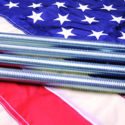NEW YORK — US steel wire rod import prices are now selling at a roughly $60-per-ton premium to domestic rod, inverting longtime trends, market participants said.
Still, cfr prices remain mostly flat as this premium is calculated with respect to loaded truck or import selling prices, according to traders, buyers and mills.
By the time import rod travels “upriver” and is delivered or close to a buyer’s facility, starting from Gulf ports, loaded truck prices could be $32 per hundredweight, one trader said. He estimated fob export prices from Vietnam at $595 per tonne, a value he last obtained two weeks ago, which translates into $640 per tonne or so cfr. He hasn’t been active in the import market because US wire drawers aren’t interested in imports at present prices.
“I haven’t heard anything” with respect to attractive or new cfr prices, this trader said. “Domestic rod prices must go up first…. The import business is not very strong right now.”
Domestic industrial-quality rod is at $29 to $29.50 per cwt, before implementation of the latest $40 per ton increase, this trader estimated, citing conversations with customers. That puts the spread at $60 per ton, favoring domestic rod, a figure in line with market estimates.
Some sources estimated that imported rod costs as much as $80 per ton more than domestic rod.
A second trader pegged domestic prices at $29.50 per cwt and import prices typically at $60 to $80 per ton above that, including from recent major exporters like Germany. He did not indicate cfr prices.
The $40-per-ton domestic price increase will see support from reduced import competition, the second trader said in echoing market chatter at the American Wire Producers Association’s government affairs conference that ended on September 27.
Lower global scrap prices have been offset by higher graphite electrode prices and reduced raw melt production, a third trader added, noting a major US electrode producer has declared force majeure and is no longer supplying electrodes.
Cfr prices are mostly flat, similar to trends seen two weeks ago, he added.
“I know scrap is down significantly, into correction territory, but no relief yet on wire rod numbers mainly due to reduced melt for want of graphite electrodes,” this trader said. “The gap is huge between offshore and domestic. Was $100 (per) ton plus … now, perhaps $60 (per) ton.”
There’s “still money being left on the table by US mills,” he said before the recent price increase took full effect. “The price inversion will certainly have an impact on imports and eventually lead to pricing power for the domestic mills. … Yet, wire drawing customers are seemingly not concerned as (US) lead times are short and (domestic) rod plentiful … for now.”
Rod imports look poised to total 86,429 tonnes for September, according to license data updated by the US Commerce Department’s Enforcement and Compliance division on September 26. That’s down from 105,292 tonnes licensed in August, in itself a low figure compared with the 2016 monthly import average of 118,600 tonnes.
Traditional rod suppliers to the US—like Turkey, Russia and Ukraine—disappeared entirely in September while Egypt, Morocco and Germany were among the major new spot suppliers.
Egypt was licensed to ship 14,486 tonnes to US shores in September, with Morocco licensed to supply 4,178 tonnes and
Germany 8,272 tonnes. Egypt and Germany had been licensed to ship 10,487 tonnes and 13,109 tonnes, respectively, the prior month while Morocco provided no material in August.
Cfr prices are mostly unchanged from two weeks ago, typically at $600 per tonne fob export from several countries, a fourth trader noted.
Import availability will be an issue in the future, he said, citing import protection mechanisms such as an ongoing wire rod trade case and a pending Section 232 investigation.
This source also noted that market forecasts were split cleanly down the middle at the recent International Rebar Exporters and Producers Association (Irepas) biannual meeting in Athens, which ended on September 26. “No real good intel” at Irepas, he said on September 27. “Probably half (of the meeting attendees) see the world market softening and the other half see it going up.”
Domestic mills “have room to move (rod prices) up for sure,” the fourth trader added, echoing market chatter.
AMM assessment for imported low-carbon wire rod, which is on a cfr basis port of Houston, remains unchanged from two weeks ago at $572 to $581 per short ton ($630 to $640 per tonne).
This content was originally written and produced by Nat Rudarakanchana at American Metal Market










